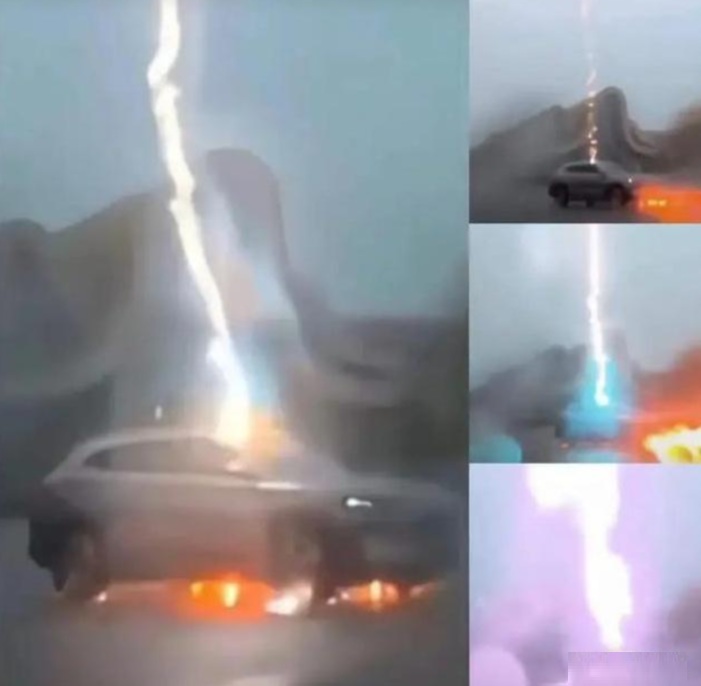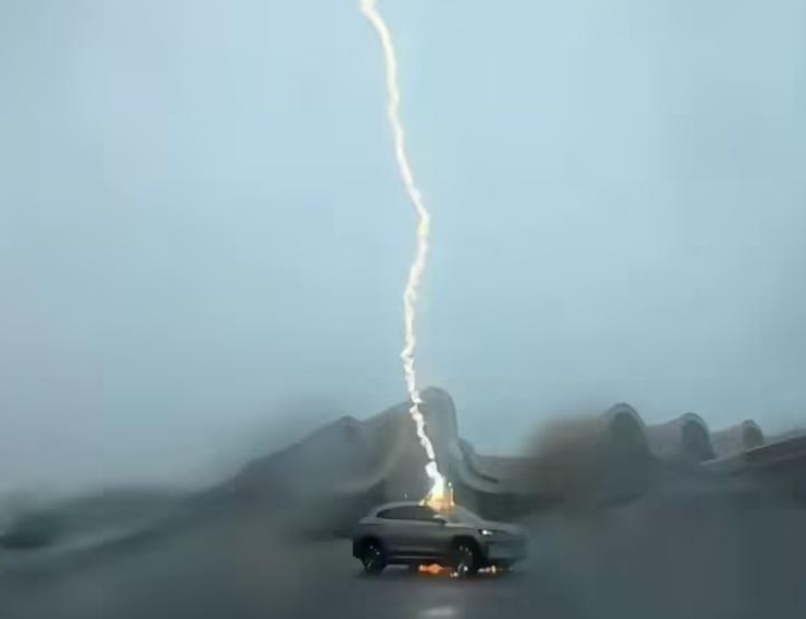On August 6, a netizen captured a shocking moment at the Tieshan Service Area in Beihai, Guangxi, where a BYD new energy vehicle was struck by lightning. The incident sparked widespread discussion on social media.
On August 7, the condition of the lightning-struck vehicle was revealed for the first time. A professional from the 4S shop responsible for inspection and maintenance stated that the vehicle’s three core components (battery pack, electronic control, and motor) showed no signs of short-circuiting. Apart from two lightning strike marks on the roof, the exterior remained undamaged. The vehicle is still under inspection, and the owner—unharmed—has filed an insurance claim.
“This is the first lightning strike case I’ve encountered in my 12-year career!” the professional noted. During the strike, the vehicle activated its power-off protection function, demonstrating robust safety features. The owner stayed inside and called for rescue while awaiting a tow truck.
Li Yunfei, General Manager of BYD’s Brand and PR Department, stated on Weibo: “The Song PLUS EV remained unscathed after multiple lightning strikes. The driver is safe, and the three-electric system is intact.”

Viewpoint 1:
This Guangxi incident is fascinating. A BYD car was struck by lightning three times consecutively, yet the driver emerged unharmed, and the vehicle didn’t shut down.
Various theories abound—some call it divine protection, others sheer luck.
First, the surface-level explanation for the driver’s safety: the Faraday cage (a concept taught in middle school physics).
A metal shell conducts electricity along its surface, not through the interior. Sitting inside the car is like being in a metal box—lightning travels from the roof to the ground, separated from you by insulation.
This applies to both electric and fuel vehicles; any proper metal-bodied car offers this protection. Thus, sheltering in a car during a thunderstorm is safer than standing outside—common sense.
But the real story isn’t the driver’s safety (which is expected). It’s that the car itself survived, and that’s intriguing.
Consider lightning’s power: instantaneous high-voltage surges of tens of thousands of amps or more. Such force could cripple a small substation, let alone an EV.
EVs are packed with electronics—batteries, motors, and controllers all rely on electricity. A high-voltage pulse should theoretically fry everything into scrap metal.
Yet this Song PLUS EV endured unscathed, including its three-electric system. A Faraday cage alone can’t explain this.
Three layers of protection were at play, each critical:
- The Faraday cage (metal shell): Protected the driver and blocked the initial electromagnetic pulse, diverting most current externally.
- Equipotential bonding + shielding: All key metal parts—especially the three-electric system’s casing—are connected via wires to the car body. This eliminates voltage differences between components, preventing lethal currents. Shielding (like “bulletproof vests” for core parts) weakens lightning’s electromagnetic field.
- Smart high-voltage cutoff protection: The true game-changer. The Battery Management System (BMS) and Vehicle Control Unit (VCU) detected the surge and severed the physical connection between the battery and motor/controller in microseconds. Like a martial artist dissipating force before impact, this isolated the battery—saving it from overload.
This three-tier defense dissipated lightning energy via the shell, grounding, and smart cutoff—sparing both car and driver.
Assessment:
This isn’t “magic” or “BYD supremacy”—it’s rigorous engineering, costly testing, and respect for extreme conditions. It shows China’s top EV makers now prioritize invisible safety (e.g., lightning protection), not just specs or screens. Such features rarely get marketed but prove decisive in emergencies.
Investing in low-probability, high-stakes scenarios reflects a mature industrial approach—emphasizing safety redundancy.
Objectively, we lack data on this lightning strike’s intensity. A stronger bolt might have different results. But this real-world test proves EVs can handle extreme weather beyond just battery safety.
This builds consumer confidence: if EVs survive lightning, daily driving feels safer. It also warns rivals: safety investments > flashy add-ons like “fridges and TVs.” Reputation is built on these overlooked details.
Lastly, kudos to the driver: staying inside post-strike was textbook. Exiting could risk “step voltage” (current passing through the body via ground potential differences).
The car is a safe refuge—if you stay in it.
This incident showcases BYD’s deep safety engineering—no hype, just proof. It marks Chinese EVs’ evolution from “functional” to “reliable.” But while tech is the baseline, driver awareness remains key.
Comments:
1.1 Driver: “Three heavenly strikes—verifiable record!”
1.2 “Transcended tribulations, ascended to immortality!”
1.3 “Need to transcend? Buy this car. Better than any talisman—and reusable.”
1.4 “BYD’s tech is legit.”
1.5 “Touting ‘smart cutoff’ against lightning is pure propaganda. Forced bragging.”
Viewpoint 2:
BYD hired lightning for safety testing—something rivals can’t replicate (lightning is random, and who’d volunteer?). Critics might joke: “Even the heavens disapprove of BYD.” But post-strike, the car worked, offering thunderstorm-prone buyers a real case study.
BYD’s safety “quadra-kill”:
- Dolphin: Rear-ended by truck—A-pillar held, driver safe.
- Tang: Hit by heavy truck—driver minor injuries.
- Leopard 5: Flood auto-escape via sunroof.
- Song PLUS: Lightning strike—no harm.
(Comments add more: Frigate 07 vs. steel coil, U8 rescuing Sylphy post-crash, Song L vs. dump truck, Song Pro vs. 18-ton truck, Leopard 5’s lights post-crash.)
Some may prioritize resale value/design over safety—fine. Let buyers self-sort: safety-first = BYD; others = rival brands. Win-win.
Viewpoint 3:
BYD’s marketing is incompetent. Competitors would milk this for hype (“crash a truck? No need!”). Yet BYD barely promoted it—missing a chance to educate on thunderstorm safety (“stay inside!”).
Viewpoint 4:
“A tribulation-transcending artifact for cultivators. Tech vs. celestial power.” But BYD’s marketing might only spawn memes like “Ride BYD, get struck.”
Viewpoint 5:
BYD’s real-world tests: trucks → steel coils → lightning. Meanwhile, rivals fake truck collisions. Inexcusable. Fire BYD’s PR team—Xiaomi’s Lei Jun would roast competitors with such material.
Viewpoint 6:
“Lightning = divine will. BYD, how dare you defy heaven? Fix this flaw!”
Viewpoint 7:
“Why struck three times? That’s the real question.”
Viewpoint 8:
“Megawatt fast-charging.” (Note: Likely sarcasm re: lightning’s power.)




